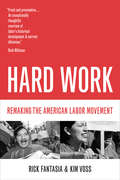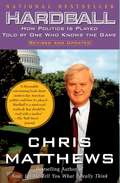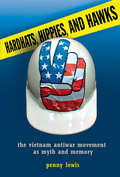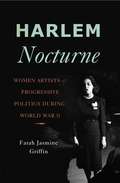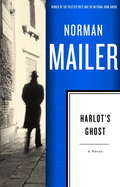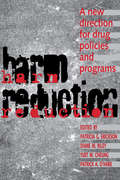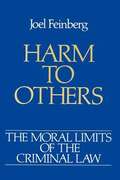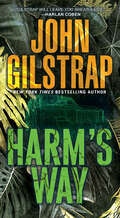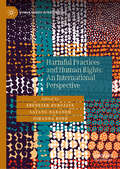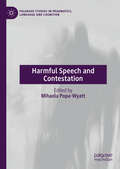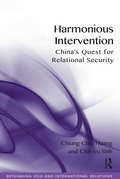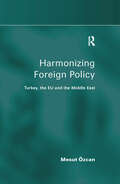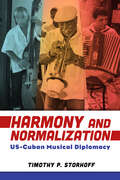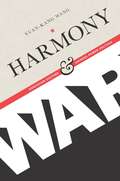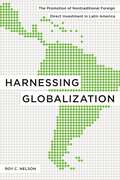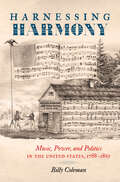- Table View
- List View
Hard Work: Remaking the American Labor Movement
by Rick Fantasia Kim VossThis concise overview of the labor movement in the United States focuses on why American workers have failed to develop the powerful unions that exist in other industrialized countries. Packed with valuable analysis and information, Hard Work explores historical perspectives, examines social and political policies, and brings us inside today's unions, providing an excellent introduction to labor in America. Hard Work begins with a comparison of the very different conditions that prevail for labor in the United States and in Europe. What emerges is a picture of an American labor movement forced to operate on terrain shaped by powerful corporations, a weak state, and an inhospitable judicial system. What also emerges is a picture of an American worker that has virtually disappeared from the American social imagination. Recently, however, the authors find that a new kind of unionism--one that more closely resembles a social movement--has begun to develop from the shell of the old labor movement. Looking at the cities of Los Angeles and Las Vegas they point to new practices that are being developed by innovative unions to fight corporate domination, practices that may well signal a revival of unionism and the emergence of a new social imagination in the United States.
Hard Work: The Making of Labor History (Working Class in American History)
by Melvyn DubofskyA career-spanning collection of writings by the legendary labor historian One of American labor history's most prominent scholars, Melvyn Dubofsky curated an accessible style and historical reach that have long marked his work as required reading for students and scholars. This collection juxtaposes Dubofsky's early writings with scholarship from the 1990s. Selections include work on western working-class radicalism, U.S. labor history in transnational and comparative settings, and the impact of technological change on American worker’s movements. Throughout, the writings provide an invaluable eyewitness perspective on the academic and political climate of the 1960s and 1970s while tracing the development of labor history as a discipline. An exploration of important themes in labor history, Hard Work combines essential scholarship with the story of how past and present interact in the work of historians.
Hardball: How Politics Is Played Told By One Who Knows The Game
by Chris MatthewsHow politics is played by one who knows the game...Chris Matthews has spent a quarter century on the playing field of American politics—from right-hand man of Speaker of the House Tip O'Neill to host of NBC's highest rated cable talk show Hardball. In this revised and updated edition of his political classic, he offers fascinating new stories of raw ambition, brutal rivalry, and exquisite seduction and reveals the inside rules that govern the game of power.
Hardhats, Hippies, And Hawks
by Penny LewisIn the popular imagination, opposition to the Vietnam War was driven largely by college students and elite intellectuals, while supposedly reactionary blue-collar workers largely supported the war effort. In Hardhats, Hippies, and Hawks, Penny Lewis challenges this collective memory of class polarization. Through close readings of archival documents, popular culture, and media accounts at the time, she offers a more accurate "counter-memory" of a diverse, cross-class opposition to the war in Southeast Asia that included the labor movement, working-class students, soldiers and veterans, and Black Power, civil rights, and Chicano activists. Lewis investigates why the image of antiwar class division gained such traction at the time and has maintained such a hold on popular memory since. Identifying the primarily middle-class culture of the early antiwar movement, she traces how the class interests of its first organizers were reflected in its subsequent forms. The founding narratives of class-based political behavior, Lewis shows, were amplified in the late 1960s and early 1970s because the working class, in particular, lacked a voice in the public sphere, a problem that only increased in the subsequent period, even as working-class opposition to the war grew. By exposing as false the popular image of conservative workers and liberal elites separated by an unbridgeable gulf, Lewis suggests that shared political attitudes and actions are, in fact, possible between these two groups.
Hardware, Software, Heartware: Digital Twinning for More Sustainable Built Environments
by Jason PomeroyThis richly illustrated book examines the full potential of Digital Twins (DTs) as a means of creating more sustainable urban habitats. It reveals how, in this digitally-enabled age, DTs are increasingly being adopted by cities as a tool for urban governance, with the hope of increasing operational efficiencies and enhancing citizens’ lives. While the study and implementation of DTs has been critically explored as virtual, dynamic 3D replicas of physical entities across different disciplines and industries, this book establishes a strategy that recognises the need for the ‘software’ behind virtual DT platforms to not only represent the ‘hardware’ of our physical cities but also to reflect the ‘heartware’ of socio-economic and cultural practices. Knowledge gaps and challenges in existing DTs are identified and insights into rethinking their purpose are provided to propose a new DT paradigm model for city-wide application. With multiple case studies illustrating the different concepts of DTs being applied in cities from Europe, North America, The Middle East, Asia and Oceania, the book highlights the reasons why and how DTs can play an integral role in the sustainability of our urban habitats. Beautifully designed and illustrated in full colour throughout, this book combines academic theory with practical application and will be a useful reference for professionals, students, academics and policymakers, working in the fields of smart cities, sustainable urbanism, and the digitisation, digitalisation and digital transformation of the built environment industry.
Harlem Nocturne: Women Artists and Progressive Politics During World War II
by Farah Jasmine GriffinAs World War II raged overseas, Harlem witnessed a battle of its own. Brimming with creative and political energy, Harlem's diverse array of artists and activists launched a bold cultural offensive aimed at winning democracy for all Americans, regardless of race or gender. In Harlem Nocturne, esteemed scholar Farah Jasmine Griffin tells the stories of three black female artists whose creative and political efforts fueled this movement for change: novelist Ann Petry, a major new literary voice; choreographer and dancer Pearl Primus, a pioneer in her field; and composer and pianist Mary Lou Williams, a prominent figure in the emergence of Be-Bop. As Griffin shows, these women made enormous strides for social justice during the war, laying the groundwork for the Civil Rights Movement before the Cold War temporarily froze their democratic dreams.A rich account of three distinguished artists and the city that inspired them, Harlem Nocturne captures a period of unprecedented vitality and progress for African Americans and women in the United States.
Harlequin Desire June 2016 - Box Set 1 of 2: A Pregnancy Scandal\Redeeming the Billionaire SEAL\Trapped with the Maverick Millionaire
by Kat Cantrell Joss Wood Lauren CananDo you love stories with sexy, romantic heroes who have it all--wealth, status, and incredibly good looks? Harlequin® Desire brings you all this and more with these three new full-length titles in one collection! A PREGNANCY SCANDAL Love and Lipstick by Kat Cantrell One broken rule. One night of passion. Now...one accidental pregnancy! A marriage of convenience is the only way to prevent a scandal for the popular senator and his no-frills CFO lover--until their union becomes so much more... REDEEMING THE BILLIONAIRE SEAL Billionaires and Babies by Lauren Canan Navy SEAL Chance Masters is only back on the family ranch until his next deployment, but can the all-grown-up girl next door struggling to raise her infant niece convince him his rightful place is at home? TRAPPED WITH THE MAVERICK MILLIONAIRE From Mavericks to Married by Joss Wood Years ago, one kiss from a hockey superstar rocked Rory's world. Now Mac needs her--as his live-in physical therapist! Despite their explosive chemistry, she keeps her hands off--until one hot island night as a storm rages... Look for Harlequin® Desire's June 2016 Box set 2 of 2, filled with even more scandalous stories and powerful heroes! Join HarlequinMyRewards.com to earn FREE books and more. Earn points for all your Harlequin purchases from wherever you shop.
Harlequin Desire June 2016 - Box Set 2 of 2: A Bride for the Boss\The Boss and His Cowgirl\Arranged Marriage, Bedroom Secrets
by Maureen Child Yvonne Lindsay Silver JamesDo you love stories with sexy, romantic heroes who have it all--wealth, status, and incredibly good looks? Harlequin® Desire brings you all this and more with these three new full-length titles in one collection! A BRIDE FOR THE BOSS Texas Cattleman's Club: Lies and Lullabies by Maureen Child When Mac's overworked assistant quits, he's left floundering. But when she challenges the wealthy rancher to spend two weeks not working--with her--he soon realizes all the pleasures he's been missing... THE BOSS AND HIS COWGIRL Red Dirt Royalty by Silver James Clay Barron is an oil magnate bred for great things. Nothing can stop his ambition--except the beautiful assistant from his hometown. Will his craving for the former cowgirl mean a choice between love and success? ARRANGED MARRIAGE, BEDROOM SECRETS Courtesan Brides by Yvonne Lindsay To prepare for his arranged marriage, Prince Thierry hires a mysterious beauty to tutor him in romance. His betrothed, Mila, mischievously takes the woman's place. But as the prince falls for his "forbidden" lover, Mila's revelations will threaten all they hold dear... Look for Harlequin® Desire's June 2016 Box set 1 of 2, filled with even more scandalous stories and powerful heroes! Join HarlequinMyRewards.com to earn FREE books and more. Earn points for all your Harlequin purchases from wherever you shop.
Harlequin Desire May 2015 - Box Set 2 of 2
by Barbara Dunlop Fiona Brand Janice MaynardDo you love stories with sexy, romantic heroes who have it all--wealth, status, and incredibly good looks? Harlequin® Desire brings you all this and more with these three new full-length titles for one great price! This Desire box set includes Minding Her Boss's Business by USA TODAY bestselling author Janice Maynard, The Sheikh's Pregnancy Proposal by Fiona Brand and Sex, Lies and the CEO by USA TODAY bestselling author Barbara Dunlop.Look for 6 new compelling stories every month from Harlequin® Desire!
Harlot's Ghost: A Novel
by Norman MailerWith unprecedented scope and consummate skill, Norman Mailer unfolds a rich and riveting epic of an American spy. Harry Hubbard is the son and godson of CIA legends. His journey to learn the secrets of his society--and his own past--takes him through the Bay of Pigs, the Cuban Missile Crisis, and the "momentous catastrophe" of the Kennedy assassination. All the while, Hubbard is haunted by women who were loved by both his godfather and President Kennedy. Featuring a tapestry of unforgettable characters both real and imagined, Harlot's Ghost is a panoramic achievement in the tradition of Tolstoy, Melville, and Balzac, a triumph of Mailer's literary prowess.
Harm Reduction
by Patricia G. Erickson Diane M. Riley Yuet W. Cheung Pat A. O'HareSince the First International Conference on the Reduction of Drug-Related Harm, held in 1990, the term 'harm reduction' has gained wide currency in the areas of public health and drug policy. Previously the field was characterized by heated struggle between prohibition and legalization of addictive substances, and this debate tended to obscure practical, collective approaches. Harm reduction, an approach which encompasses various policy directives and program initiatives was inspired by the positive outcomes of such public measures as needle-exchange programs for reduction of HIV risk, methadone maintenance programs, education on the risks of tobacco use, and programs designed to limit alcohol consumption.The essays in this book illustrate the scope and vigour of the emerging harm reduction model. The essays, drawn from seven international conferences on harm reduction, cover a wide variety of topics, including public policy, women and reproductive issues, the experiences of special populations, human rights; defining and measuring harm, and intervention.Researchers and practitioners will benefit from the varied papers in the volume, which combine insights into policy-making and front-line outreach efforts with comprehensive conceptual and empirical approaches. Harm Reduction represents an important initiative in making academic work accessible and useful to a larger community, and provides guidance for the development of effective policies and programs.
Harm To Others: The Moral Limits of the Criminal Law, Volume 1
by Joel FeinbergThis first volume in the four-volume series The Moral Limits of the Criminal Law focuses on the "harm principle," the commonsense view that prevention of harm to persons other than the perpetrator is a legitimate purpose of criminal legislation. Feinberg presents a detailed analysis of the concept and definition of harm and applies it to a host of practical and theoretical issues, showing how the harm principle must be interpreted if it is to be a plausible guide to the lawmaker.
Harm's Way (A Jonathan Grave Thriller #15)
by John GilstrapThe exhilarating new thriller from the New York Times and USA Today bestselling author takes readers on an action-packed thrill ride across rural Venezuela. The kidnappers are ruthless. The stakes are high. The odds are impossible. There&’s no way Jonathan Grave can say no… &“[Gilstrap&’s] greatest strength is the ability to blend breathtaking action with deep emotion regarding the characters.&” —Jeffery Deaver Henchmen of a vicious drug syndicate have snatched ten missionaries in a remote area of Venezuela and are holding them for ransom. The high-priority rescue op comes as a personal plea from FBI Director Irene Rivers, who has a very special interest in one of the hostages. The mission is strictly off the books, and there can be no international incident. Just get in and get out—and keep the precious cargo safe. With his key operatives Gunslinger and Boxers, Grave infiltrates the enemy camp. Right away, the rescue mission morphs into something far more dangerous—not just to Jonathan and his team, but to the whole world.&“I read HARM&’S WAY in one sitting, including through dinner. Loved the book! John Gilstrap fast became one of my favorite authors. I look forward to many more good reads like this one.&” –Fern Michaels
Harmful Practices and Human Rights: An International Perspective (Human Rights Interventions)
by Ebenezer Durojaye Johanna Bond Satang NabanehHarmful Practices and Human Rights examines different forms of harmful practices, globally, which constitute human rights violations as guaranteed in international and regional human rights instruments. Drawing examples from Africa, Asia, North America, Europe, and Australasia, it demonstrates how these practices undermine the right to health, including sexual and reproductive health, and also impugn the dignity and autonomy of women and girls. Using diverse harmful practices as case studies, the book critically examines the factors that drive harmful practices in developing and developed countries. Specifically, this book focuses on a selection of harmful practices—including dowry payments, ukuthwala, intimate partner violence, harmful tobacco use and its gendered implications, trafficking in persons, widowhood practices, the chinamwari/khomba practice, and child marriage—from both the Global South and North. Its intent is to demonstrate the prevalence of these abuses and underscore the urgent need for states to take decisive steps toward eradication.
Harmful Speech and Contestation (Palgrave Studies in Pragmatics, Language and Cognition)
by Mihaela Popa-WyattThis edited book explores how harmful speech works, how it can be used to change societies in bad ways and how we can defend against it. Harmful speech comes in a variety of forms, including hate speech, dehumanizing speech, misogynistic speech, derogatory speech, misgendering, marginalizing speech, and much more. What is common to all these types of speech is that they don’t just offend but seek to harm members of vulnerable groups, so that they feel humiliated, attacked, denigrated, silenced, and dehumanised. These harms are not confined to the conversation in which such speech is used, but may involve various downstream effects such as moral, social, and epistemic harms. Harmful speech may also shift social norms by changing people’s opinions and ultimately changing norms about how targets ought to be treated. Harmful speech uses this effect to establish and maintain oppressive norms, entrench hierarchies and shape power relations. The contributions in this volume examine the mechanisms underlying various forms of harmful speech and possible responses and remedies. They combine a variety of tools and perspectives, including philosophy of language, linguistics, ethnography, with a particular focus on issues in the semantics/pragmatics of derogatory expressions, speech acts and conversational dynamics. The chapters bring these conversations together and highlight the ways in which philosophers of language have sought to build bridges in recent years with social and political philosophy concerned with the nature of oppression and responses to it. These topics offer the opportunity for a valuable integration of insights from different perspectives.
Harmonic Innovation: Super Smart Society 5.0 and Technological Humanism (Lecture Notes in Networks and Systems #282)
by Domenico Marino Francesco Cicione Luigino FiliceThis book is aimed at researchers, entrepreneurs, and innovation consultants of the 5.0 era. For many centuries, the dominant paradigm of innovation was based on competition and the protection of the achievements (closed innovation).In the early years of the new millennium, the advent of globalization and the network has made the model evolve towards open and collaborative approaches (open innovation).Both methods corresponded to a different view of the world and society.Today, in a historical phase in which the world needs to become more sustainable and equitable, from the heart of the Mediterranean, the cradle of classical civilization, a group of valuable academics, scholars, and entrepreneurs propose to the world a new and further evolution of the concept of innovation and expression of the era we are living in: the harmonic innovation, an attempt to combine science and wisdom, technique and spirit, scientific research and moral research, technological progress and new humanism, new economy and social impacts, power, and limit.Anybody who aims to discover a fragment of future is welcome to read this book.
Harmonious Intervention: China's Quest for Relational Security (Rethinking Asia and International Relations)
by Chiung-Chiu Huang Chih-yu ShihTwo major features of international relations at the beginning of the 21st century are global governance and the rise of China. Global governance, advocating global norms, requires intervention into sovereign domains in defiance of those norms. However, an ascendant China adheres to a classic stance on sovereign integrity which prohibits such intervention. Whether or not China will ultimately Sinicize global governance or become assimilated into global norms remains both a theoretical and a practical challenge. Both challenges come from China’s alternative style of global governance, which embodies the doctrine of 'balance of relationship,' in contrast with the familiar international relations embedded in ’balance of power’ or ’balance of interest.’ An understanding of China’s intervention policy based upon the logic of balance of relationship is therefore the key to tackling the anxiety precipitated by these theoretical as well as practical challenges.
Harmonizing Foreign Policy: Turkey, the EU and the Middle East
by Mesut ÖzcanThe change in Turkish foreign policy towards the Middle East in the post-Cold War era is a highly debated issue, with most experts believing that Europeanization has become the driving force behind this change. This book takes the cases of Iraq and the Palestinian-Israeli conflict as two important illustrations. Both cases present dynamic issues of conflict in the region and are high on Turkey's agenda in terms of its policies towards the region. Focusing on issues related to EU integration, the study examines the formation of a common foreign policy in general and a common policy towards the Middle East in particular. It also investigates decision making in Turkish foreign policy and foreign policy towards the Middle East before and after EU candidature. As such it provides valuable insights into how parties interact with each other and the way in which foreign policies can be harmonized.
Harmony and Normalization: US-Cuban Musical Diplomacy
by Timothy P. StorhoffHarmony and Normalization: US-Cuban Musical Diplomacy explores the channels of musical exchange between Cuba and the United States during the eight-year presidency of Barack Obama, who eased the musical embargo of the island and restored relations with Cuba. Musical exchanges during this period act as a lens through which to view not only US-Cuban musical relations but also the larger political, economic, and cultural implications of musical dialogue between these two nations. Policy shifts in the wake of Raúl Castro assuming the Cuban presidency and the election of President Obama allowed performers to traverse the Florida Straits more easily than in the recent past and encouraged them to act as musical ambassadors. Their performances served as a testing ground for political change that anticipated normalized relations. While government actors debated these changes, music forged connections between individuals on both sides of the Florida Straits. In this first book on the subject since Obama’s presidency, musicologist Timothy P. Storhoff describes how, after specific policy changes, musicians were some of the first to take advantage of new opportunities for travel, push the boundaries of new regulations, and expose both the possibilities and limitations of licensing musical exchange. Through the analysis of both official and unofficial musical diplomacy efforts, including the Havana Jazz Festival, the National Symphony Orchestra of Cuba’s first US tour, the Minnesota Orchestra’s trip to Havana, and the author’s own experiences in Cuba, this ethnography demonstrates how performances reflect aspirations for stronger transnational ties and a common desire to restore the once-thriving US-Cuban musical relationship.
Harmony and War: Confucian Culture and Chinese Power Politics
by Yuan-Kang WangConfucianism has shaped a certain perception of Chinese security strategy, symbolized by the defensive, nonaggressive Great Wall. Many believe China is antimilitary and reluctant to use force against its enemies. Instead, the country practices pacifism and refrains from expanding its boundaries, even when nationally strong. In a path-breaking study that travels seven hundred years of Chinese history, Yuan-kang Wang resoundingly discredits this notion, recasting China as a practitioner of realpolitik and a ruthless purveyor of expansive grand strategies. Leaders of the Song Dynasty (960-1279) and Ming Dynasty (1368-1644) prized military force and shrewdly assessed the strength of China's adversaries. They adopted defensive strategies only when their country was weak and pursued expansive goals, such as territorial acquisition, enemy destruction, and total military victory, when their country was strong. Despite the dominance of an antimilitarist Confucian culture, warfare was not uncommon in the bulk of Chinese history. Grounding his research in primary Chinese sources, Wang outlines a politics of power that are crucial to understanding China's strategies today, especially its policy of "peaceful development," which it has adopted only because of military, economic, and technological weakness in relation to the United States.
Harmony and War: Confucian Culture and Chinese Power Politics (Contemporary Asia in the World)
by Yuan-kang WangConfucianism has shaped a certain perception of Chinese security strategy, symbolized by the defensive, nonaggressive Great Wall. Many believe China is antimilitary and reluctant to use force against its enemies. It practices pacifism and refrains from expanding its boundaries, even when nationally strong. In a path-breaking study traversing six centuries of Chinese history, Yuan-kang Wang resoundingly discredits this notion, recasting China as a practitioner of realpolitik and a ruthless purveyor of expansive grand strategies. Leaders of the Song Dynasty (960-1279) and Ming Dynasty (1368-1644) prized military force and shrewdly assessed the capabilities of China's adversaries. They adopted defensive strategies when their country was weak and pursued expansive goals, such as territorial acquisition, enemy destruction, and total military victory, when their country was strong. Despite the dominance of an antimilitarist Confucian culture, warfare was not uncommon in the bulk of Chinese history. Grounding his research in primary Chinese sources, Wang outlines a politics of power that are crucial to understanding China's strategies today, especially its policy of "peaceful development," which, he argues, the nation has adopted mainly because of its military, economic, and technological weakness in relation to the United States.
Harnessing Complexity for Better Outcomes in Public and Non-profit Services
by Rob Wilson Melissa Hawkins Max French Hannah Hesselgreaves Toby LoweePDF and ePUB available Open Access under CC-BY-NC-ND licence. How can public services and social interventions create and sustain good outcomes for the populations they serve? Building on research in public health, social epidemiology and the social determinants of health, this book presents complexity theory as an alternative basis for an outcome-oriented public management praxis. It takes a critical approach towards New Public Management and provides new conceptual inroads for reappraising public management in theory and practice. It advances two practical approaches: Human Learning Systems (a model for public service reform) and Learning Partnerships (a model for research and academic engagement in complex settings). With up-to-date and extensive discussions on public service reform, this book provides practical and action-oriented guidance for a radical change of course in management and governance.
Harnessing Foreign Investment to Promote Environmental Protection
by Jorge E. Viñuales Pierre-Marie DupuyHarnessing Foreign Investment to Promote Environmental Protection investigates the main challenges facing the implementation of environmental protection and the synergies between foreign investment and environmental protection. Adopting legal, economic and political perspectives, the contributing authors analyse the various incentives which encourage foreign investment into pro-environment projects (such as funds, project-finance, market mechanisms, payments-for-ecosystem services and insurance) and the safeguards against its potentially harmful effects (investment regulation, CSR and accountability mechanisms, contracts and codes of conduct).
Harnessing Globalization: The Promotion of Nontraditional Foreign Direct Investment in Latin America
by Roy C. NelsonHow can countries in the underdeveloped world position themselves to take best advantage of the positive economic benefits of globalization? One avenue to success is the harnessing of foreign direct investment (FDI) in the “nontraditional” forms of the high-technology and service sectors, where an educated workforce is essential and the spillover effects to other sectors are potentially very beneficial. In this book, Roy Nelson compares efforts in three Latin American countries—Brazil, Chile, and Costa Rica—to attract nontraditional FDI and analyzes the reasons for their relative success or failure. As a further comparison, he uses the successes of FDI promotion in Ireland and Singapore to help refine the analysis. His study shows that two factors, in particular, are critical. First is the government’s autonomy from special interest groups, both domestic and foreign, arising from the level of political security enjoyed by government leaders. The second factor is the government’s ability to learn about prospective investors and the inducements that are most important to them—what he calls “transnational learning capacity.” Nelson draws lessons from his analysis for how governments might develop more effective strategies for attracting nontraditional FDI.
Harnessing Harmony: Music, Power, and Politics in the United States, 1788–1865
by Billy ColemanFollowing the creation of the United States, profound disagreements remained over how to secure the survival of the republic and unite its diverse population. In this pathbreaking account, Billy Coleman uses the history of American music to illuminate the relationship between elite power and the people from the early national period to the Civil War. Based on deep archival research in sources such as music periodicals, songbooks, and manuals for musical instruction, Coleman argues that a particular ideal of musical power provided conservative elites with an attractive road map for producing the harmonious union they desired. He reassesses the logic behind the decision to compose popular patriotic anthems like "The Star-Spangled Banner," reconsiders the purpose of early American campaign songs, and brings to life a host of often forgotten but fascinating musical organizations and individuals. The result is not only a striking interpretation of music in American political life but also a fresh understanding of conflicts that continue to animate American democracy.
